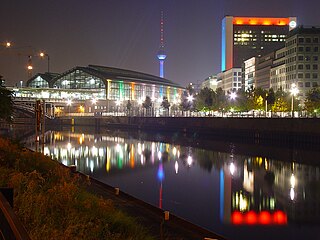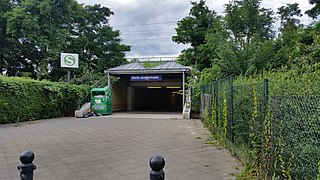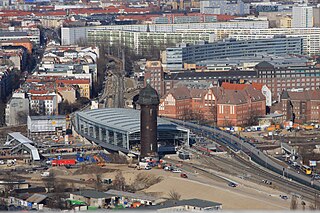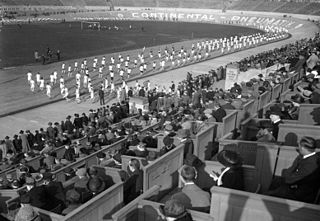
The Berlin S-Bahn is a rapid transit railway system in and around Berlin, the capital city of Germany. It has been in operation under this name since December 1930, having been previously called the special tariff area Berliner Stadt-, Ring- und Vorortbahnen. It complements the Berlin U-Bahn and is the link to many outer-Berlin areas, such as Berlin Brandenburg Airport. As such, the Berlin S-Bahn blends elements of a commuter rail service and a rapid transit system.
S9 is a line on the Berlin S-Bahn. It operates from Flughafen BER to Spandau through Berlin Hauptbahnhof over:

Berlin Jungfernheide is a railway station located at Charlottenburg-Nord, in the Charlottenburg-Wilmersdorf district of Berlin, served by the S-Bahn lines S41 and S42, the U-Bahn line U7 and Regional-Express trains of the Deutsche Bahn. Its name literally translates into "maidens' heathland"; it was named after the Jungfernheide, a former large forest in the proximity of this station.

Berlin Ostkreuz station is a station on the Berlin S-Bahn suburban railway and the busiest interchange station in Berlin. It is in the former East Berlin district of Friedrichshain, now part of the borough of Friedrichshain-Kreuzberg. A smaller part of the station is in Rummelsburg, part of the borough of Lichtenberg. The station is a Turmbahnhof with the Berlin–Frankfurt (Oder) railway and the Prussian Eastern Railway on the lower level and the Berlin Ringbahn on the upper level. It is used by a total of around 235,000 passengers every day on eight lines, entering or leaving.

The Berlin Stadtbahn is the historic east-west elevated railway of Berlin. It runs from Friedrichshain in the east to Charlottenburg in the west, connecting several of the most major sights of the German capital. The line is protected cultural heritage since 1995. It is often defined more simply as the slightly longer route between Ostkreuz and Westkreuz, although this is not technically correct.

The Ringbahn is a 37.5 km (23.3 mi) long circle route around Berlin's inner city area, on the Berlin S-Bahn network. Its course is made up of a pair of tracks used by S-Bahn trains and another parallel pair of tracks used by various regional, long distance and freight trains. The S-Bahn lines S41 and S42 provide a closed-loop continuous service without termini. Lines S45, S46 and S47 use a section of the southern and western ring, while lines S8 and S85 use sections of the eastern ring. The combined number of passengers is about 400,000 passengers a day. Due to its distinctive shape, the line is often referred to as the Hundekopf.

Westend is a locality of the Berlin borough Charlottenburg-Wilmersdorf in Germany. It emerged in the course of Berlin's 2001 administrative reform on the grounds of the former Charlottenburg borough. Originally a mansion colony, it is today a quite densely settled, still affluent territory adjacent to Berlin's inner city in the east.

Berlin-Spandau station is a Deutsche Bahn station in the Berlin district of Spandau on the south-western edge of the old town of Spandau. The railway junction station is one of the 80 stations classified by Deutsche Bahn as a category 2 station. It has the longest train shed in Germany.

Westend is a station in the Charlottenburg district of Berlin. It is located on the Ringbahn circle line, served by the S-Bahn lines S41, S42 and S46. It is named after the Westend locality, which is immediately adjacent to the station grounds. The entire station area was opened—as Charlottenburg-Westend—in several stages from 15 November 1877, but it has since been reduced to an S-Bahn platform and a pair of long-distance tracks. The station was closed temporarily in 1980 because of the S-Bahn strike. A platform on the Ringbahn was reopened in 1993 for S-Bahn traffic. The restoration of all of the station infrastructure is not planned.

Messe Nord/ICC (Witzleben) is a station in the Charlottenburg district of Berlin. It is located on the Ringbahn circle line, served by S-Bahn lines S41/S42 and S46. It is linked to the Kaiserdamm U-Bahn station on line U2 via a short footpath.

Berlin Westkreuz is a station in the Charlottenburg district of Berlin. It is served by the S-Bahn lines S3, S41, S42, S46, S5, S7 and S9 and so represents a major interchange point on the Berlin S-Bahn network. It lies at the opposite end of the Stadtbahn to Ostkreuz and is one of the four main stations on the Ringbahn.

Halensee is a station on the Berlin Ringbahn in the Halensee district of Berlin. It is served by the S-Bahn lines S41, S42 and S46.

Heerstraße is a railway station in Berlin, Germany. It is located on the Spandau Suburban Line in the Westend district and served by S-Bahn S3 and S9 trains. The station is today listed as a historical monument.

Olympiastadion is a railway station in the Westend district of Berlin. Located at the southern entrance of the Olympic Stadium, it is served by the S-Bahn lines S3 and S9. The station consists of one island platform which is in regular use, as well as four further terminal island platforms which are only used for the extra trains during major events.

Berlin has developed a highly complex transportation infrastructure providing very diverse modes of urban mobility. 979 bridges cross 197 kilometers of innercity waterways, 5,334 kilometres (3,314 mi) of roads run through Berlin, of which 73 kilometres (45 mi) are motorways. Long-distance rail lines connect Berlin with all of the major cities of Germany and with many cities in neighboring European countries. Regional rail lines provide access to the surrounding regions of Brandenburg and to the Baltic Sea.

Deutsches Stadion was a multi-use sports stadium in Berlin, Germany. It was located at Deutsches Sportforum in the present-day Westend quarter on the northern rim of the large Grunewald forest. Built according to plans designed by Otto March, it was opened on 8 June 1913, on the occasion of Emperor Wilhelm II's silver jubilee, due to host the 1916 Summer Olympics that were cancelled after the outbreak of World War I. The stadium was demolished 20 years later and replaced by the current Olympiastadion.

Grunewald is a German forest located in the western side of Berlin on the east side of the Havel, mainly in the Grunewald locality. At 3,000 hectares it is the largest green area in the city of Berlin.

The Berlin–Lehrte railway, known in German as the Lehrter Bahn, is an east–west line running from Berlin via Lehrte to Hanover. Its period as a separate railway extended from its opening in 1871 to the nationalisation of its owner, the Magdeburg-Halberstadt Railway Company on 1 July 1886. The company's Berlin station, the Lehrter Bahnhof was finally torn down in 1958.

Siemensstadt-Fürstenbrunn station was a suburban station on the Berlin–Hamburg railway in Westend, a locality of the Charlottenburg-Wilmersdorf borough in Berlin. It was primarily built for workers at its nearby Siemens Works in the neighbouring quarter of Siemensstadt.

The Berlin S-Bahn began on 8 August 1924 with the first section from Stettiner Vorortbahnhof to Bernau using steam locomotives. On 13 August 1961 it was broken up when the Berlin Wall was built, resulting in two sections: the eastern part and the western part. The western part experienced a massive strike which resulted in closure of several stations, after declining use. Attempts were made to reopen at various times but in the end, only three lines were finally opened after the strike. Since 9 November 1989, when the Berlin Wall was opened, the Berlin S-Bahn began to expand rapidly with their budgetary costs.





















